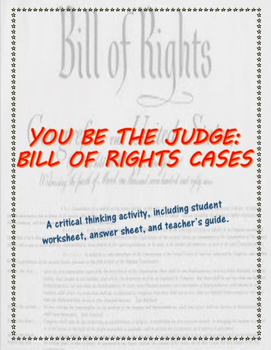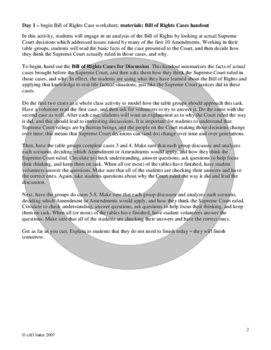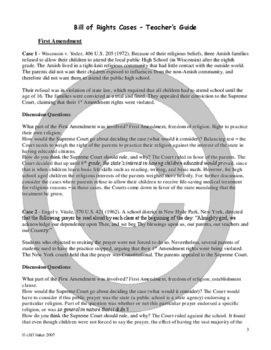You Be the Judge - analyzing Supreme Court cases on the Bill of Rights
Ye Olde US History Emporium
161 Followers
Grade Levels
7th - 11th, Homeschool
Subjects
Resource Type
Standards
CCSSCCRA.R.1
CCSSCCRA.R.2
CCSSCCRA.R.4
CCSSCCRA.R.6
CCSSCCRA.R.8
Formats Included
- Zip
Pages
19 pages
Ye Olde US History Emporium
161 Followers
What educators are saying
My students loved this activity. We made it a carousel activity where they went around the room and analyzed each case separately.
Description
It’s one thing to simply memorize the Bill of Rights; it’s quite another to actually understand how they apply in everyday life. Teaching the former gives students words but no understanding for what they mean; teaching the latter gives students practice in critical thinking as well as a deep appreciation for their basic rights as American citizens. It is, in effect, the ultimate lesson in civics.
This activity is designed to teach students the meaning and application of the Bill of Rights by having students “be the judge;” they will read brief summaries of cases that came before the Supreme Court and decide how the Court should have ruled in applying the Bill of Rights to those actual cases. They will then learn how the Court actually ruled to help deepen their understanding of both how the Bill of Rights applies in real life, and how the Court goes about making its decisions. In effect, it has students learn to think like constitutional lawyers.
These materials – all of which have been battle-tested in the crucible of my own 8th grade classroom - include:
* a 4 page worksheet with 12 cases and discussion questions, covering the 1st, 4th, 5th and 6th Amendments;
* a teacher’s guide with answers as to how the Supreme Court actually ruled in those cases, and why it made the ruling that it did;
* an 8 page Teacher’s Guide which provides step-by-step instructions how to use the materials;
All materials are provided as word documents and PDFs in one zip file.
This activity is part of a complete and comprehensive unit on the Constitution and Bill of Rights, as well as part of a complete mini-unit solely on the Bill of Rights.
For more like this, visit my store: Ye Olde US History Emporium
Visit me on Facebook at @YeOldeHistoryTeacher
This activity is designed to teach students the meaning and application of the Bill of Rights by having students “be the judge;” they will read brief summaries of cases that came before the Supreme Court and decide how the Court should have ruled in applying the Bill of Rights to those actual cases. They will then learn how the Court actually ruled to help deepen their understanding of both how the Bill of Rights applies in real life, and how the Court goes about making its decisions. In effect, it has students learn to think like constitutional lawyers.
These materials – all of which have been battle-tested in the crucible of my own 8th grade classroom - include:
* a 4 page worksheet with 12 cases and discussion questions, covering the 1st, 4th, 5th and 6th Amendments;
* a teacher’s guide with answers as to how the Supreme Court actually ruled in those cases, and why it made the ruling that it did;
* an 8 page Teacher’s Guide which provides step-by-step instructions how to use the materials;
All materials are provided as word documents and PDFs in one zip file.
This activity is part of a complete and comprehensive unit on the Constitution and Bill of Rights, as well as part of a complete mini-unit solely on the Bill of Rights.
For more like this, visit my store: Ye Olde US History Emporium
Visit me on Facebook at @YeOldeHistoryTeacher
Total Pages
19 pages
Answer Key
Included
Teaching Duration
2 days
Report this resource to TPT
Reported resources will be reviewed by our team. Report this resource to let us know if this resource violates TPT’s content guidelines.
Standards
to see state-specific standards (only available in the US).
CCSSCCRA.R.1
Read closely to determine what the text says explicitly and to make logical inferences from it; cite specific textual evidence when writing or speaking to support conclusions drawn from the text.
CCSSCCRA.R.2
Determine central ideas or themes of a text and analyze their development; summarize the key supporting details and ideas.
CCSSCCRA.R.4
Interpret words and phrases as they are used in a text, including determining technical, connotative, and figurative meanings, and analyze how specific word choices shape meaning or tone.
CCSSCCRA.R.6
Assess how point of view or purpose shapes the content and style of a text.
CCSSCCRA.R.8
Delineate and evaluate the argument and specific claims in a text, including the validity of the reasoning as well as the relevance and sufficiency of the evidence.





